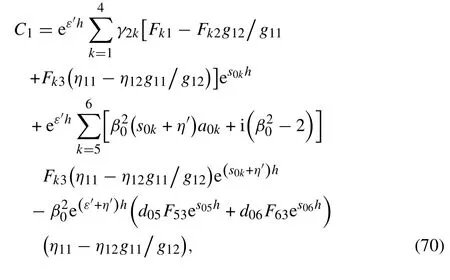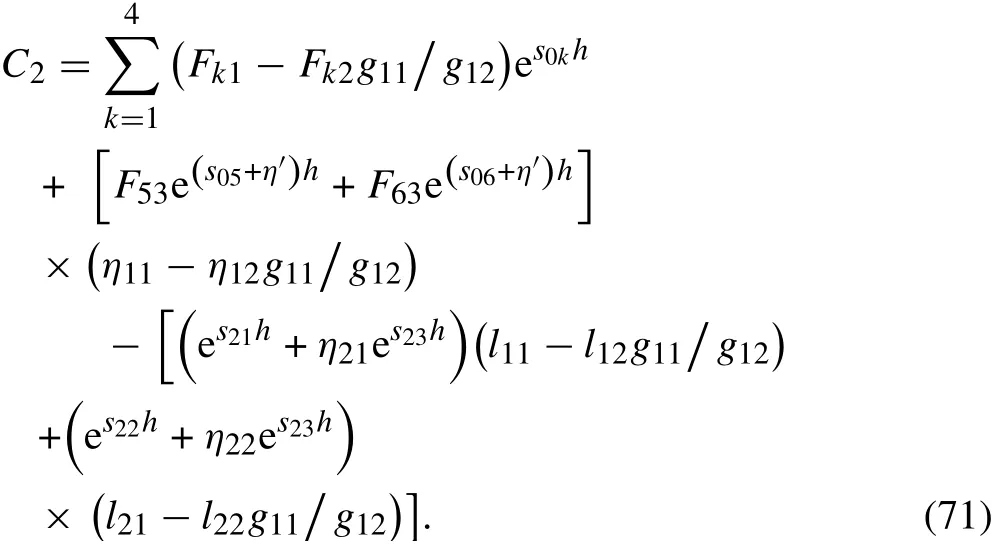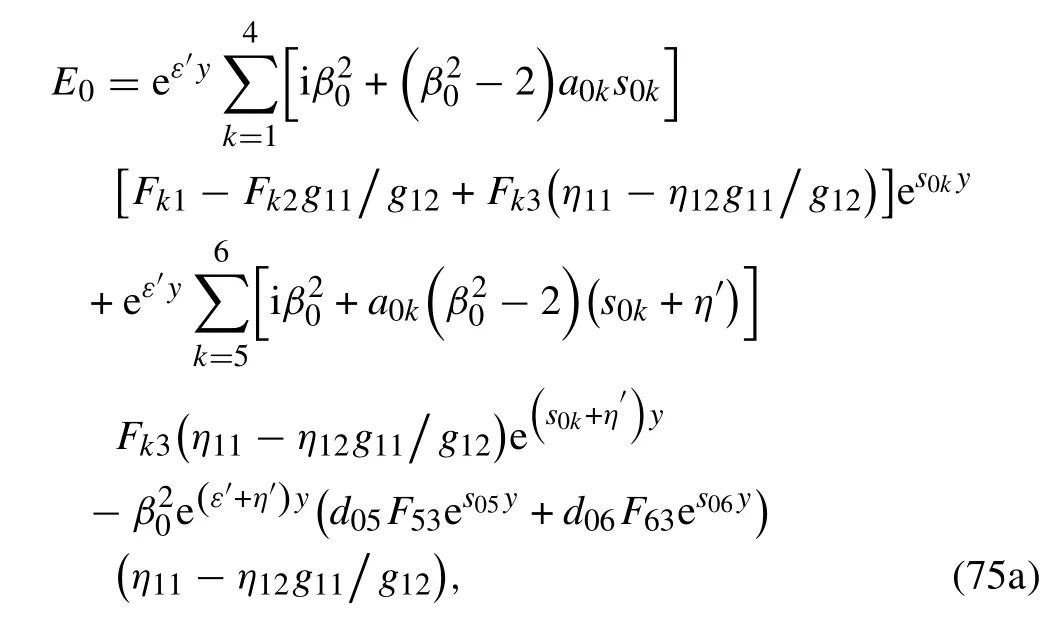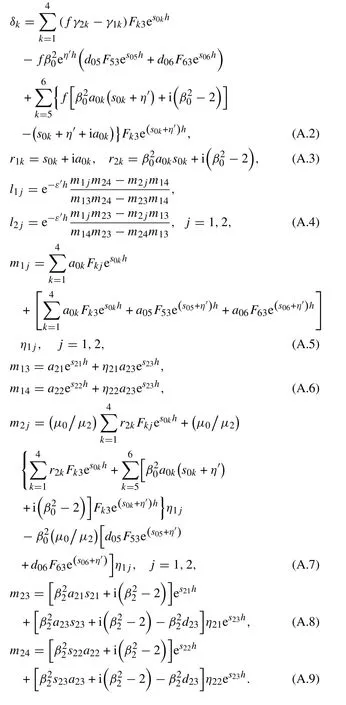Frictionally excited thermoelastic dynamic instability of functionally graded materials
J. Liu·L. L. Ke·Y. S. Wang
Abstract The perturbation method is applied to investigate the frictionally excited thermoelastic dynamic instability (TEDI) of a functionally graded material (FGM) coating in half-plane sliding against a homogeneous half-plane. We assume that the thermoelastic properties of the FGM vary exponentially with thickness.We also examine the effects of the gradient index,sliding speed,and friction coefficient on the TEDI for various material combinations.The transverse normal stress for two different coating structures is calculated. Furthermore, the frictional sliding stability of two different coating structures is analyzed.The obtained results show that use of FGM coatings can improve the TEDI of this sliding system and reduce the possibility of interfacial failure by controlling the interfacial tensile stress.
Keywords Thermoelastic dynamic instability·Frictional heat·Functionally graded materials·Stress analysis
1 Introduction
The effective material properties of functionally graded materials (FGMs) can change in a continuous and smooth manner,sincetheyareusuallyformedfromtwodistinctmaterial phases with continuously varying fractions [1]. Over the past 20 years, contact problems involving FGMs have attracted attention from many researchers.The frictional contact problem of an FGM coating structure acted on by rigid parabolic and cylindrical stamps was analyzed by Guler and Erdogan[2-5],whereas El-Borgi et al.[6]and Elloumi et al.[7]investigated the axisymmetric receding contact problem for FGMs and the fully coupled partial slip contact problem for a graded layer.A linear multilayer model was developed by Ke and Wang [8] to analyze the fretting contact problem for FGM coating structures. Such studies in the fields of tribology and contact mechanics suggest that resistance to contact deformation and damage can be improved by using FGM coatings[9-18].
In recent years,researchers have paid more attention to the thermoelastic contact of FGMs, due to their excellent thermomechanical properties.Since FGMs are frequently used in high-temperature environments,it is important to understand their thermoelastic contact properties for use in practical applications. It was Choi and Paulino [19] and Barik et al.[20] who first tried to investigate the thermoelastic contact problem of FGM coatings and interlayers,investigating the effect of frictional heat generation on the contact stress distributions.With consideration of frictional heat,Shahzamanian et al.[21,22]used the finite element method to solve the temperature and contact stress distributions in an FGM rotating brake disk.The thermoelastic frictional contact problem of a graded layer was investigated by Chen et al.[23,24],who also discussed the interface traction and temperature distribution under a prescribed thermoelastic environment for different parameter combinations.The cited results show that FGMs have great potential to provide better resistance in such thermoelastic contact problems.
For the sliding frictional contact problem, the frictional heatgenerationatthecontactinterfacedependsonthecontact pressure,friction coefficient,and sliding speed.If the sliding speed exceeds a critical value,the contact becomes unstable under small perturbations.This class of instability involving coupled thermal and mechanical effects is called frictionally excited thermoelastic instability(TEI)[25].The hot spot and hot judder effects in brakes and clutches are related to TEI.Some numerical and theoretical results have shown that FGMs have potential to enhance the stability behavior of brake and clutch systems [26-29]. The frictionally excited TEI of FGMs in brake and clutch systems was first considered[26-28],including the thermoelastic contact problems of an FGM-coated disk,an FGM half-plane sliding against a homogeneous half-plane,and an FGM layer sliding against two homogeneous half-planes. It was observed by Hernik[29] that application of FGMs in brake disk structures can reduce the possibility of TEI,compared with homogeneous materials.These results showed that FGMs can delay interface separation and improve contact stability in frictional sliding systems.
Work by Afferrante et al.[30-34]revealed that the inherent elastodynamic vibration mode becomes unstable because of the extremely weak coupling between elastodynamic and thermoelastic effects,resulting in instability of the system at any, low speed. This new phenomenon is known as thermoelastic dynamic instability (TEDI). They considered a homogeneous elastic layer sliding against a rigid half-plane and two conducting elastic half-spaces sliding each other.Morerecently,Liuetal.[35]investigatedtheTEDIofanelastichalf-planeslidingagainstahomogeneouslayerhalf-plane.Because of the advantages of FGMs in improving frictionally excited TEI,we believe that FGMs could be further used to improve the TEDI of sliding systems.However,to date,literature on TEDI of FGMs remains very limited.The dynamic instability of an FGM-coated structure with exponentially varying elastic properties was analyzed recently by Liu et al.[36]. However, they did not consider the thermal effect on the dynamic contact characteristics of the FGM.
In the present study,we examined the stability of the thermoelastic wave caused by a perturbation in an FGM-coated structure,with consideration of frictional heat.The thermoelastic properties of the FGM coating are assumed to vary exponentially through the coating thickness. The effects of the gradient index,friction coefficient,and sliding speed on the TEDI of the sliding system are discussed.Furthermore,the transverse normal stress distribution in the depth direction is calculated for a homogeneous half-plane with an FGM or homogeneous coating.
We studied the TEI of FGMs in our previous papers[36-38].However,that work considered the dynamic instability of the FGM coating structure without taking account of the thermal effect[36]or only studied the static thermoelastic instability of FGMs induced by the pressure-dependent thermal contact resistance[37,38].In this paper,we attempt to improve these studies by:(1)taking account of the coupling between thermal and dynamic effects, (2) considering the dynamic effect on the TEI of FGMs,and(3)paying special attention to the thermal stress distribution in FGM-coated structures, which is important for understanding interfacial failure.
2 Problem description
In this paper,we consider a homogeneous elastic,conducting half-plane (half-plane 2 in Fig.1)sliding(with relative speedagainst an FGM-coated half-plane(half-plane 1 in Fig.1).As shown in Fig.1,the normal forceand tangential forceare applied to half-plane 2.Coulomb friction is assumed to occur at the contact surface,i.e.,

with f being the friction coefficient, generating heat at the interface.The heat flux is equal to the product of the contact pressure,friction coefficient,and sliding speed

The contact problem is defined in a coordinate systemmoving with constant speedwheredoes not necessarily equal. The homogeneous half-plane 1 and half-plane 2 have mass density ρ1and ρ2, shear modulus μ1and μ2,thermal expansion coefficient α1and α2,thermal conduction coefficient K1and K2, and thermal diffusivity coefficient k1and k2,respectively.It is assumed that the FGM coating and the lower half-plane are perfectly bonded to each other,and that the thermoelastic properties of the FGM vary in the thickness direction according to the exponential forms

where ρ0,μ0,α0,and K0are the mass density,shear modulus, thermal expansion coefficient, and thermal conduction coefficient at the bottom (ˆy = 0) of the FGM coating,respectively, while ε, η, and τ are the gradient indexes.The Poisson's ratio and thermal diffusivity coefficient are assumed to be constant(ν0and k0)for simplicity.
We now study the stability of the above sliding system.We assume that the system is disturbed by a small perturbation, then analyze the properties of the thermoelastic wave formed and propagating in it. The sliding is stable if this thermoelastic wave decays with time;otherwise,the sliding is unstable.
For linear isotropic elastic half-planes,the thermoelastic wave motion equations based on the moving coordinate system can be written as


Fig.1 Homogeneous elastic half-plane sliding against an FGM-coated half-plane

where ν is the Poisson's ratio. For the FGM coating, the thermoelastic wave motion equations are

In the next sections,we examine the stability of the thermoelastic wave by solving Eqs.(4)-(9)under the boundary conditions.
3 Thermoelastic wave field
The following quantities are introduced:

These are made dimensionless using the characteristic length l defined as

whereω andλarethewavenumberandwavelengthoftheperturbation, respectively. Using the dimensionless quantities,the thermoelastic wave motion Eqs.(4)-(6)can be expressed in dimensionless form as


where

with subscripts j = 1, 2 denoting the half-planes 1 and 2, respectively, and V2-V1= V0, V0=It is assumed that the constantand V2are the sliding speeds of the half-planes 1 and 2,respectively.
For the FGM coating,Eqs.(7)-(9)can be rewritten as

with

In addition,the constitutive relations between the dimensionless stress and displacement are defined by


We can obtain the constitutive relations for the lower and upper homogeneous half-planes from Eqs.(20)-(22)by setting ε′=η′=0.
We suppose a perturbed temperature and displacements of the form

Substituting Eqs.(23)-(25)into Eqs.(12)-(14)yields

with j=1,2.The general solutions for the lower half-plane can be expressed as

with

and

The general solutions for the upper half-plane are


with

and

The general solutions for the FGM coating are given by

where

with

and


In Eqs. (32), (38), and (44), the multivaluedfunctions are taken as the branches with positive real part.
Since the FGM coating is perfectly bonded to half-plane 1,the components of the displacement and stress on the bonded interface (y = 0) satisfy the continuity conditions. We can write them in dimensionless form as

The perturbation of temperature is also continuous at y=0 as

where

We can express Eqs. (47)-(49) in matrix form with the help of general solutions Eqs.(29)-(31)and Eqs.(41)-(43):

with Vs(x,0,t)= ˆVs(x,0,t)/Cs1and P0= ˆP0/μ1.In addition, we consider that the frictional heat, the continuity of temperature,and the heat flux on the frictional sliding interface(y=-h)can be formulated as
with

The solution of Eq.(51)is

where Fkjis the element of matrixFinally, the dimensionless displacement and stress at the frictional sliding interface (with y = -h) are required to satisfy the boundary conditions

Substituting Eqs.(35)-(37),Eqs.(41)-(43),and Eq.(53)into Eqs.(54)and(55)yields

where η1j,η2j,l1j,and l2j(j=1,2)are given in the Appendix.
Half-plane 1 is regarded as stationary,while half-plane 2 moves along the x-direction with speed ˆV0. Therefore, the dimensionless speed(Vs)and contact traction(P)at the contact interface are


with

Substituting Eqs.(58)and(59)into Eq.(61)and dropping the second-order term in the product(PVs)yields

with

Substitution Eqs.(35)-(37),Eqs.(41)-(43),and Eqs.(58)and(59)into Eqs.(60)and(63)yields

with

The nontrivial solution of Eq.(65)requires

Whenthematerialproperties,frictioncoefficient,andsliding speed are given,the complex nonlinear Eq.(68)can be solved using the iterative method and the unknown complex b obtained.Then,at the contact interface,the dimensionless contact traction(P)and dimensionless speed(Vs)can be calculated via

with


4 Results and discussion
Whentheeffectofthematerialgradientpropertyisneglected,we can simplify the problem as two half-planes sliding against each other, just like the study of the TEDI by Afferrante et al. [34] between two frictional sliding elastic homogeneous half-spaces. Thus we conduct a direct comparison between those results reported by Afferrante et al.[34] and ours. The effect of the sliding speed (V0) on the critical friction efficient(fcr)is presented in Fig.2,revealing excellent agreement between the present results and those in Ref.[34].
The dynamic instability of the FGM-coated structure was analyzed by Liu et al.[36],who found that the instability of the Adams'family wave occurs at almost zero friction with small mass density ratio ρ2/ρ1.For the Rice's family wave,the instability occurs at small friction when the mass density ratio ρ2/ρ1is more 10 times larger than the modulus ratio μ2/μ1.However,the material combination in the latter case is rare in nature. Furthermore, the thermoelastic dynamic instability of the homogeneous coated structure was studied byLiuetal.[35],whofoundthattheAdams'familywavewas more susceptible to thermoelastic dynamic instability than the Rice's family wave for the same material combinations.Therefore, this paper only presents the stability of Adams'family wave for common material combinations and small friction coefficient.We assume that the reference coordinate systemisfixedtothelowerFGM-coatedhalf-plane,i.e.,V1=0andV2=-V0.Thethermoelasticpropertiesarecontinuous at the bonded interface y=0,i.e.,ρ0=ρ1,μ0=μ1,α0=α1,K1=K2,and k0=k1,and the gradient indexes satisfy ε′=τ′=η′=λ.Also,the Poisson's ratios of all materials are chosen as ν1=ν0=ν2=0.25,γ =10-4,and H1=1[30,39].

Fig.2 Relations of fcr versus V0 for P0 = 0.1, χ = 0.2, γ = 10-4,α1/α2 =1.2,k1/k2 =0.1,and K1/K2 =0.1
4.1 Effect of gradient index on TEDI
Figures 3, 4, and 5 show the relations of the dimensionless gradient index (λ) and exponential growth rate bRfor various material combinations (χ22, μ1μ2). It is seen that bRremains unchanged when λ is less than a certain negative value;if λ is further increased,bRfluctuates and then decreases gradually to zero.For given shear wave speed ratio(χ22), bRincreases with decrease of μ1/μ2when λ is positive and χ22≤1; bRincreases with increase ofand the range of λ for instability increases when χ2>12(Fig.3).For given shear modulus ratio μ1μ2,bRincreases with decrease of χ22.The range of λ for instability increases when λ is larger than a certain positive value (Fig. 4). Figure 5 shows that bRdecreases with increase ofwhen we selectInterestingly,one can observe that the sliding is stable when the gradient index is larger than a certain positive value,remains unchanged when the gradient index is less than a certain negative value,and fluctuates with change of the gradient index from negative to positive.
4.2 Effects of friction coefficient and sliding speed on TEDI
Figure 6 shows the relations of the friction coefficient f and exponential growth rate bRfor different values of the gradient index λ. Note that, for fixed gradient index λ, bRincreases with increase of the friction coefficient. It is also seen that different values of the gradient index correspond to different critical friction coefficients.The relations of the dimensionless sliding speed V0and exponential growth rate bRfor some selected values of gradient index λ are presented in Fig. 7.Note that bRdecreases gradually to zero with increase of the sliding speed.This implies that the system is susceptible to TEDI even at small sliding speed.We define a critical sliding speed Vcrwhen the exponential growth rate bRis zero.It is also shown that,for fixed V0,this critical sliding speed Vcrincreases with increase of the gradient index. These results imply that one can modify the sliding stability,critical friction coefficient, and critical sliding speed by adjusting the gradient index of the FGM coating.

Fig.3 Relations of bR versus λ with k1/k2 = 0.1, α1/α2 = 1.2, and K1/K2 =0.1:a =1.0,b =0.5,c =1.5
4.3 Thermal stress distribution
It is known that FGM coatings are better for controlling interfacial tensile stress compared with homogeneous coatings.This can improve sliding stability and reduce the possibility of interfacial failure [36]. To confirm this advantage of FGM coatings,this section presents the distribution of transverse normal thermal stress in the thickness direction, and examines the effect of the FGM coating on it. We discuss two cases: (1) an FGM coating with continuous material properties at the bonded interface y = 0, i.e., ρ0= ρ1, μ0= μ1, α0= α1, K0= K1, and k0= k1, where the material parameters of the lower and upper half-planes satisfyand the coating gradient index is defined as λ =2)a homogeneous coating with the same material properties as those of the upper half-plane.

Fig.4 Relations of bR versus λ with k1/k2 = 0.1, α1/α2 = 1.2, and K1/K2 =0.1:a μ1/μ2=1.0,b μ1/μ2=0.5,c μ1/μ2=1.5
As the stress increases with time,the calculation is for the moment when loss of contact is just initiated,i.e.,

with


Fig.5 Relations of bR versus λ with k1/k2 = 0.1, α1/α2 = 1.2, and K1/K2 =0.1

Fig.6 Relations of bR versus f with P0 = 0.1, V0 = 0.1, χ22 = 0.3,μ1/μ2=0.3,k1/k2 =0.1,α1/α2 =1.2,and K1/K2 =0.1

Fig.7 Relations of bR versus V0 with f = 0.2, P0 = 0.1, χ22 = 0.8,μ1/μ2=0.5,k1/k2 =0.1,α1/α2 =1.2,and K1/K2 =0.1
Then,for the FGM-coated structure,the amplitude of the tensile stresses can be expressed as


Fig.8 Magnitude of dimensionless transverse normal stress(|σxx|)with ψ =0.4:a-f h =0.1,0.2,0.3,0.4,0.5,0.6
with



Fig.9 Effect of dimensionless layer thickness h on the distribution of the dimensionless dynamic normal stress(|σxx|)with ψ =0.4
For the homogeneous coated structure,the results can be obtained from Eq.(74)by setting ε′=η′=0.
The amplitudes of the dimensionless transverse normal stresses |σxx|for the two different coated structures with a selected coating thickness are presented in Fig. 8a-e. The amplitude of the dimensionless interfacial stress is continuous at the bonded interface y = 0 for the FGM-coated structure, while that in the homogeneous coated structure is discontinuous because of the mismatch in materials properties between the lower half-plane and the coating. With decrease of the coating thickness, the discontinuity in the amplitude of the thermoelastic dynamic interfacial stress becomes increasingly obvious at the bonded interface y =0 in the homogeneous coated structure. Furthermore, the amplitude of the thermoelastic dynamic interfacial stress in the homogeneous coated structure is lower than that in the FGM-coated structure at the sliding interface y =-h.This continuous and smooth stress distribution can significantly reduce the possibility of interfacial failure in the FGM-coated structure.
Figure 9 shows the relations of the amplitude of the dimensionless transverse normal stresses|σxx|and the dimensionless layer thickness for the FGM-coated structure,revealing that the amplitude of |σxx| decreases with increase of the coating thickness at the bonded interface y=0 as well as at the sliding interface y=-h.At y=0,the effect of the coating thickness on the distribution of |σxx|for some selected values of ψ in the FGM-coated structure is shown in Fig.10,revealing that the amplitude of|σxx|decreases with decreasing value of the material mismatch parameter ψ at y = -h. These results indicate that the amplitude of the interface stress can be effectively reduced by changing the coating thickness properly. This is of practical importance because large tensile stress|σxx|is the main cause of interfacial cracking.

Fig.10 Relations of |σxx|versus h for selected values of ψ at the bonded interface y=0

Fig.11 Variation of the exponential growth rate bR with dimensionless layer thickness h for ψ =0.4

Fig.12 Variation of the exponential growth rate bR with ψ for h=0.4
Analysis of the stability of the two different coated structures for selected coating thicknesses are presented in Figs. 11 and 12. For the given material mismatch,bRincreases as the coating thickness increases for both coated structures, whereas bRin the FGM-coated structure is less than that in the homogeneous coated structure,especially for large coating thickness (Fig. 11). For given coating thickness, bRin the FGM-coated structure is less than that in the homogeneous coated structure, especially for large material mismatch (Fig. 12). These results imply that the frictional sliding of the FGM-coated structure is more stable than that of the homogeneous coated structure,especially for large coating thickness and/or large material mismatch.
5 Conclusions
By considering the stability of the Adams' family wave caused by a perturbation, this paper investigates the frictionally excited TEDI of an FGM-coated structure. The thermoelastic properties of the FGM are assumed to vary exponentially with thickness.We examined the effects of the coating gradient index,sliding speed,and friction coefficient on the TEDI for various material combinations. In addition, we calculated the transverse normal stresses varying in the thickness direction for two different coating structures and analyzed the effects of the FGM coating on the stress distribution and frictional sliding stability.It is found that:
1. The exponential growth rate remains unchanged when the gradient index is less than a certain negative value.As the gradient index increases from negative to positive,the exponential growth rate fluctuates then decreases gradually to zero.
2. Theresultsimplythatonecanmodifytheslidingstability,critical friction coefficient,and critical sliding speed by adjusting the gradient index of the FGM coating.
3. Unlike the homogeneous coating structure, the FGMcoated structure has continuous tensile stresses at the bonded interface.
4. The amplitude of the interface tensile stress can be effectively reduced by changing the FGM coating thickness properly. This means that FGM-coated structures are more effective for controlling the interfacial tensile stress.One can use this to reduce the possibility of interfacial failure.
AcknowledgementsThe work was supported by the National Natural Science Foundation of China(Grants 11502089 and 11725207).
Appendix


- Acta Mechanica Sinica的其它文章
- Instability inspection of parametric vibrating rectangular Mindlin plates lying on Winkler foundations under periodic loading of moving masses
- GRAPHIC ABSTRACT
- Mechanism of wavy vortex and sign laws in flow past a bluff body:vortex-induced vortex
- Study on vibration of dragon wash basin and free surface waves inside
- Spectral measurements of hypervelocity flow in an expansion tunnel
- Quasi-static simulation of droplet morphologies using a smoothed particle hydrodynamics multiphase model

